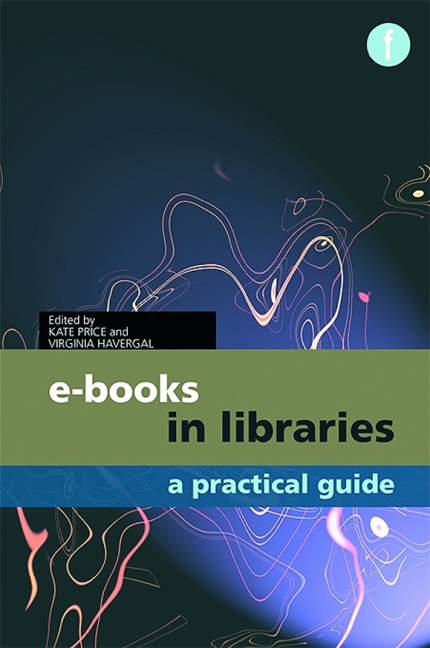Book contents
- Frontmatter
- Contents
- Preface
- The contributors
- Editors’ note
- Introduction
- Part 1 The production and distribution of e-books
- Part 2 Planning and developing an e-book collection
- Part 3 Delivering e-books to library users
- 8 Making e-book collections visible to readers
- 9 Providing guidance, training and support for readers using e-books
- 10 Information technology and e-books: challenges and opportunities
- Part 4 Engaging readers with e-books
- Part 5 The future of e-books
- Part 6 Useful information
8 - Making e-book collections visible to readers
from Part 3 - Delivering e-books to library users
Published online by Cambridge University Press: 08 June 2018
- Frontmatter
- Contents
- Preface
- The contributors
- Editors’ note
- Introduction
- Part 1 The production and distribution of e-books
- Part 2 Planning and developing an e-book collection
- Part 3 Delivering e-books to library users
- 8 Making e-book collections visible to readers
- 9 Providing guidance, training and support for readers using e-books
- 10 Information technology and e-books: challenges and opportunities
- Part 4 Engaging readers with e-books
- Part 5 The future of e-books
- Part 6 Useful information
Summary
Introduction
It has always been a challenge to make virtual library collections visible. Options for physical signposts to e-books are limited – users cannot browse the shelves to see what is available, look at a new book display, or discover a book on the reshelving trolley – all of which puts more emphasis on the effectiveness of the library catalogue as a means to highlight the availability of library e-books. However, the cataloguing of e-books presents some significant challenges, and a recent report found that many libraries struggle to catalogue all of their e-book holdings (Research Information Network, 2009).
Conversely, the visibility of e-books in the wider world has increased significantly in recent years. The increasing popularity of e-book readers and now the iPad has raised the profile of books in e-formats, and, with their facilities for full-text searching, sites such as Amazon and Google Book Search make e-books for consumers easy to find and purchase. For those trying to make library e-books visible, however, this creates another challenge. If libraries are to be effective in connecting users with their ebooks, they need to consider additional options that could offer more effective and efficient ways to increase the exposure of library e-books, alongside the traditional library catalogue.
E-books on the web
Studies show that a decreasing number of library users start their search with the library catalogue, and are instead beginning with Google and other search engines (CIBER, 2008). For users, these offer two major advantages over the library catalogue: they can search in more detail, and they can cover more content. As Anderson (2010) points out, a catalogue listing the contents of a local collection was an acceptable discovery tool in the past, where the average user only had access to whatever was available in the library. But in a world where search engines make it easy to both identify and gain access to full-text content outside the library collection, users wish to search beyond the limits of the local catalogue.
- Type
- Chapter
- Information
- E-books in LibrariesA practical guide, pp. 141 - 162Publisher: FacetPrint publication year: 2011
- 1
- Cited by

